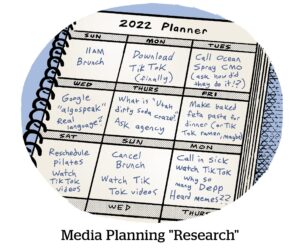Here’s today’s AdExchanger.com news round-up… Want it by email? Sign up here.
Can’t Spell “Brain Drain” Without AIs
Silicon Valley giants bet the house on machine learning software to automate their businesses, and bringing that same automation to advertisers.
Meta, Alphabet and Microsoft execs used the word “AI” more than 200 times in investor calls last week, according to Bloomberg.
Also last week, Amazon announced an upgrade to its machine learning capabilities, which will be baked into its ad system, Neal Richter, Amazon DSP’s director of data science engineering, told AdExchanger.
There are degrees of responsibility for AI products – some programs auto-generate code or content, whereas Google Performance Max and Meta Advantage+ Shopping Campaigns authorize algos to draw on bank accounts.
And that went horribly wrong a week ago, when a glitch in Meta’s campaign automation tech wasted hundreds of millions of advertisers’ dollars.
AI is “the one area where executives are emphatically promising to spend gobs of cash” during this downturn, writes Bloomberg.
Another way to frame it is that, as AI products improve, companies can automate away those roles.
But, for Meta, AI derailed the train, and the engineers needed to fix things were laid off.
Pindow Shopping
Pinterest and Amazon announced a multiyear partnership which makes Amazon Ads the first third-party ad tech to serve ads to Pinterest.
Pinterest’s blog post says it is “opening up third-party ad demand,” starting with Amazon Ads, but will add other partners eventually.
The deal makes sense for Pinterest, which must break into new advertiser categories and add competition in verticals where it has strong roots. There are probably hundreds, if not thousands, of vendors on Amazon that sell party supplies, say, and don’t advertise on Pinterest – even though party planning is a Pinterest strongpoint. Pinterest also got a PR win on earnings day.
But Amazon Ads is still the big winner here. Until Pinterest adds other third-party demand partners, Amazon has an exclusive ad-serving window (not counting Pinterest itself) on a neat bit of addressable, high-shopping-intent media.
Pinterest also only earns CPMs from Amazon-served ads.
“Duh,” you say.
Except, it’s a big deal. Pinterest hands the customer to Amazon – which outright owns the purchase data. Also, as Amazon finetunes Pinterest ads to convert at higher rates, the gains accrue to Amazon. If Pinterest charged an affiliate-style commission or CPC, it would grow, too, as Amazon’s efficiency improved.
Bird Cage
Brands aren’t the only ones fleeing Elon Musk’s Twitter. Publishers are also reducing ad spend and content on the platform in the wake of Musk’s “free speech absolutist” approach to content moderation and the overhaul of its user verification, Digiday reports.
“No one really wants to put their budget or energy into maximizing a platform that feels toxic and unstable,” says Melissa Chowning at Twenty-First Digital, an audience development firm.
A recent MediaRadar study found that 17 major US publishers, including Axios, CNN and HuffPost, spent just $279K on Twitter ads from January to February 2023, compared to $1.7 million during the same period last year. And The Atlantic, The Guardian and The Gist all confirmed to Digiday that they no longer run paid posts on the platform.
In addition to Musk’s policy changes, Twitter just isn’t a great traffic source for most publishers these days. Chartbeat says referral traffic from Twitter to media sites dipped by 20% in 2022. And 2023 referral traffic for some publishers dropped by almost half YoY.
But some publishers are more positive. News org 1440 says it’s spending six figures on Twitter ads per month since December, and Twitter has generated 10% of its audience growth over that period.
But Wait, There’s More!
Two years into Apple’s ATT, ad tech still sees growth despite slowdowns. [Digiday]
I was able to fool my bank and my family using AI-generated clones of my voice and in video. [WSJ]
Brands send cheap merch to social influencers all the time. But the practice rates poorly for sustainability and ROI. [Ad Age]
As other companies return to growth, Snap’s ad sales are down for the first time as a public company. [NYT]
















